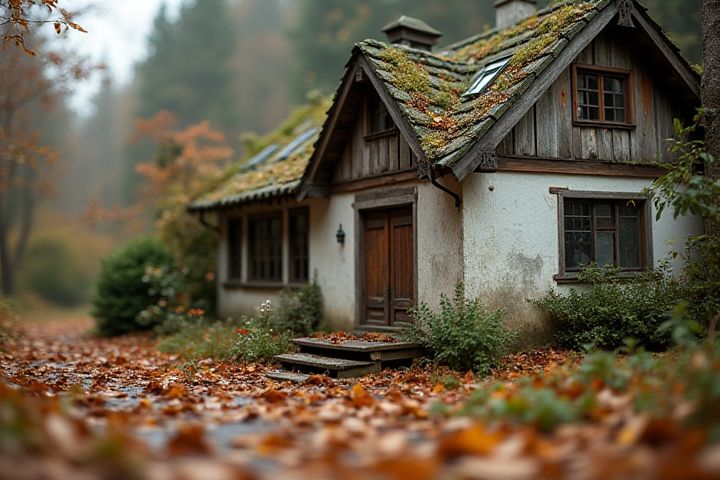
Seasonal house maintenance involves tasks that ensure your home remains in optimal condition throughout the year. In spring, focus on inspecting the roof for damage, cleaning gutters, and testing your air conditioning system. Summer maintenance includes monitoring the lawn, applying pest control treatments, and checking outdoor plumbing for leaks. As fall approaches, it's essential to winterize your home by flushing the water heater, sealing windows and doors, and cleaning the fireplace. In winter, inspect insulation, monitor heating systems, and clear snow from paths and roofs to prevent ice dams and structural damage.
What House Maintenance Is Seasonal
Gutter cleaning
Gutter cleaning is an essential seasonal maintenance task that prevents water damage to your home's foundation and exterior. During the fall, leaves and debris accumulate, blocking the flow of rainwater, which can lead to overflowing gutters and potential roof leaks. In spring, it's important to check for any winter buildup that could obstruct drainage, ensuring that your gutters are clear and functioning properly. Regular gutter cleaning can also deter pests such as rodents and insects, protecting your home from infestations.
HVAC system inspection
Seasonal house maintenance should include a thorough HVAC system inspection to ensure optimal performance and efficiency. During spring and fall, check and replace air filters to improve air quality and system longevity. Inspect ductwork for any leaks or blockages, as these can affect heating and cooling efficiency. Lastly, schedule professional servicing to clean coils and check refrigerant levels, which can prevent costly repairs and enhance energy efficiency throughout the year.
Lawn care and landscaping
Lawn care and landscaping require seasonal attention to ensure healthy growth and vibrant aesthetics. In spring, fertilization, aeration, and overseeding are crucial for establishing a lush, green lawn. During summer, regular mowing, watering, and pest control help maintain your landscape's vitality amidst heat stress. In fall, raking leaves, applying winterizing fertilizers, and preparing shrubs and trees for colder months not only protect your landscape but also enhance its visual appeal when spring arrives again.
Roof inspection
Regular roof inspections are crucial for maintaining the integrity of your home, particularly before winter and after severe storms. During these inspections, you should check for loose or damaged shingles, rust on metal flashing, and signs of water damage in the attic. Depending on your roof's material, such as asphalt shingles or tiles, you may need to clean gutters and remove debris to prevent water pooling and ice dams, which can lead to costly repairs. This proactive approach not only extends the lifespan of your roof but also enhances your property's overall value, potentially saving you thousands in unexpected maintenance costs.
Chimney sweeping
Seasonal chimney sweeping is crucial for maintaining optimal fireplace safety and efficiency. During the fall, before you ignite your first fire, hiring a professional chimney sweep ensures that creosote buildup, a flammable byproduct of combustion, is removed effectively. Yearly inspections can also identify potential structural issues within your chimney, preventing costly repairs and minimizing fire hazards. Regular maintenance not only enhances your heating system's performance but also protects your home from smoke damage and carbon monoxide risks.
Exterior painting touch-ups
Seasonal house maintenance should prioritize exterior painting touch-ups to protect and enhance your home's curb appeal. Regular inspections of your siding, trim, and doors can identify chipped or faded paint that exposes surfaces to moisture and decay. Using high-quality, weather-resistant paints facilitates longevity, while timely touch-ups maintain the aesthetic value of your property. For best results, focus on painting during mild weather conditions to ensure optimal adhesion and curing of the paint.
Window and door sealing
Inspecting and sealing windows and doors is crucial for energy efficiency and comfort during seasonal transitions. In fall, prioritize weatherstripping to prevent drafts and moisture ingress, which can lead to higher heating costs and potential damage. During spring, check for wear and tear on existing seals, replacing any that are compromised to maintain optimal airflow and insulation. Proper sealing not only enhances energy savings but also improves indoor air quality, making your home more welcoming year-round.
Deck and patio upkeep
Spring is the ideal season to inspect your deck and patio for winter damage, clear debris, and perform deep cleaning to extend their lifespan. Consider applying a protective sealant to wooden surfaces to guard against moisture and UV damage. In summer, ensure that outdoor furniture is properly maintained and arranged for optimal usability, while checking for signs of rust or deterioration on metal elements. Fall is the perfect time to clean and protect surfaces from leaf buildup and prepare for the winter months by ensuring proper drainage and structural stability.
Seasonal pest control
Seasonal pest control is crucial for maintaining a healthy home environment, particularly in preventing infestations from common pests such as ants, termites, and rodents. In spring, focus on sealing cracks and gaps in your home's exterior to deter ants and wasps, while implementing preventive measures against termites, which can cause extensive structural damage. During summer, keep your yard tidy by trimming overgrown vegetation, regularly mowing the lawn, and inspecting outdoor furniture for signs of pests. In fall, prioritize the treatment of your home's foundation and entry points to reduce the risk of rodents seeking shelter indoors during colder months.
Pool maintenance
Seasonal pool maintenance involves several key steps to ensure a safe and inviting swimming environment. In spring, it's crucial to inspect and clean the pool's filter system, check for leaks, and balance the water chemistry, ideally maintaining pH levels between 7.2 and 7.8. During summer, you should regularly skim debris, vacuum the pool floor, and monitor chlorine levels, typically maintaining a concentration of 1-3 ppm for disinfection. As autumn approaches, consider covering your pool to prevent debris accumulation while also winterizing it by lowering the water level and adding a winterizing chemical kit to protect your pool structure and plumbing.
